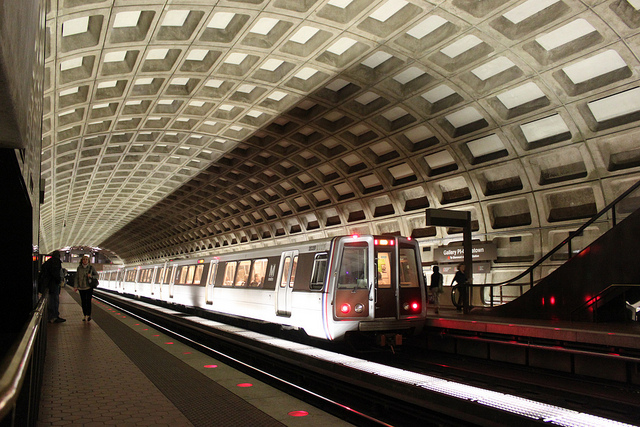WASHINGTON — Metro riders may soon see fewer delays, fewer accidents and incidents and more police in stations. Those are the goals of the new head of the troubled, 40-year-old rail system, but he’s facing huge challenges, as a Metro report released Thursday vividly illustrated.
“From the start, my priorities have been around safety, service reliability and getting the fiscal management in order,” Paul Wiedefeld, who was appointed Metro general manager in November, told the National Press Club on Monday. Before he joined WMATA, he was CEO of Baltimore/Washington International Thurgood Marshall Airport.
At the Press Club, Wiedefeld laid out his plans for safer and more reliable service by focusing on the “nuts and bolts” of Metro’s rail system: the rail cars, the tracks and the station operations.
“It’s probably much worse than I expected,” he conceded.
Three days later, on Thursday, Metro’s annual “vital Signs” report, the organization’s self-assessment, backed him up, detailing widespread failings during 2015.
Metro failed to hit its targets for bus and rail on-time performance and reliability, as well as and customer service, according to its report. Rail-on-time performance fell from 91 percent in 2014 to 84 percent in 2015, the report said.
Over the past year, a number of accidents and crime incidents – combined with nearly daily delays somewhere in the system – have caused extreme frustration and anger among many Metro customers. Customer satisfaction is at a low of 25 percent for train reliability and at 23 percent for bus reliability, Metro’s report found.
Indeed, Metro riders often are confronted with serious delays due to unpredictable track work. Malfunctioning doors, brakes, and propulsion systems lead to frequent unloading of passengers and taking cars out of service.
Last year, on Jan. 12, a smoke-filled-train in a tunnel near L’Enfant Plaza. Commuters were trapped and had to wait over 40 minutes to be rescued by firefighters. Eighty four people were hospitalized and there was one fatality.
Although crime in Metro facilities and parking lots decreased by 17 percent in 2015, according to the report, some high-profile-cases have shaken the public’s trust in Metro’s safety.
On Nov. 22, Calvin Lawrence and his partner Joseph Cowart were attacked on the Green Line by over a dozen teenagers who yelled anti-gay slurs at them.
A 41-year-old man suffered from a serious concussion and a broken jaw after he was attacked on the Red Line on Dec. 21.
“You know, numerically, it’s a very safe system when you look at it. It’s six [major] crimes per million passengers. And if you look in most communities, that’s a very safe number,” Wiedefeld said. “That means nothing to the person or to the community when they see one of these tragic events or drastic events that occurs.”
In 2015, there were 75 percent more injuries suffered when train doors closed down on customers than in 2014. The majority of the incidents involved attempts by passengers to exit crowded trains, according to Metro’s report.
The report also revealed that employee injuries rose nearly 30 percent compared to 2014, totaling to about 630 injuries.
In order to provided better customer service, Metro is already increasing police patrols, hastening the delivery of new, 7000-series rail cars, and installing cabling in the tunnels so that customers can have cell-phone service.
“What I would see is police officers around the station kiosk. I want them on platforms. I want them popping into trains,” Wiedefeld said. “That’s a different policing strategy. So that’s where I think it is. It’s physically getting the police officers into the system, deeper into the system.”
One of the major actions that Wiedefeld is implementing is the creation of an online Customer Accountability Report (CARe), where customers can see the status of actions that WMATA is taking to improve the system. The report is already up and running and customers can access it through the WMATA website.
“Some of these things will be updated weekly, monthly at a minimum,” Wiedefeld said. “And then things will come and go. I only wanted to put things on there that I’m comfortable saying, ‘Yes, I know what we’re doing, and this is the schedule we’re going to do it on.’ And then let’s judge ourselves against that.”
“There’ll always be issues with schedules, I get that,” he said. “But I think it’s important for us to be both transparent about it and then also turn up the accountability on us.”
Wiedefeld also plans to introduce platform attendants at the busiest stations in order to facilitate the flow of riders. According to CARe, as of March 6, Metro is training current staff to assist commuters at L’Enfant Plaza, Metro Center, Gallery Place, Union Station, Anacostia, and Rosslyn stations.
Metro’s new chief said he plans to reduce the annual capital plan to about $950 billion from the projected $1.1 billion because usually the capital budget in underspent. A potential sale of the Metro headquarters could create significant revenue to support customer service activities, according to a Metro news release.
“First and foremost is safety, that’s going to be the first priority,” Wiedefeld said.

